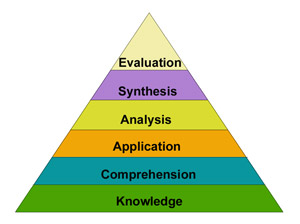Bloom's Taxonomy of Cognitive Domain
|
Bloom identified six levels within the cognitive domain, from
the simple recall or recognition of facts, as the lowest level, through increasingly
more complex and abstract mental levels, to the highest order which is classified
as evaluation. A description of the six levels as well as verb examples that
represent intellectual activity are listed here.
 Knowledge
is defined as remembering of previously learned material. This may involve
the recall of a wide range of material, from specific facts to complete theories,
but all that is required is the bringing to mind of the appropriate information.
Knowledge represents the lowest level of learning outcomes in the cognitive
domain.
Knowledge
is defined as remembering of previously learned material. This may involve
the recall of a wide range of material, from specific facts to complete theories,
but all that is required is the bringing to mind of the appropriate information.
Knowledge represents the lowest level of learning outcomes in the cognitive
domain.
Verbs: arrange, define,
duplicate, label, list, memorize, name, order, recognize, relate, recall,
repeat, reproduce state.
Comprehension
is defined as the ability to grasp the meaning of material. This may be shown
by translating material from one form to another (words to numbers), by interpreting
material (explaining or summarizing), and by estimating furture trends (predicting
consequences or effects). These learning outcomes go one step beyond the simple
remembering of material, and represent the lowest level of understanding.
Verbs: classify, describe,
discuss, explain, express, identify, indicate, locate, recognize, report,
restate, review, select, translate.
Application
refers to the ability to use learned material in new and concrete situations.
This may include the application of such things as rules, methods, concepts,
principles, laws, and theories. Learning outcomes in this area require a higher
level of understanding than those under comprehension.
Verbs: apply, choose,
demonstrate, dramatize, employ, illustrate, interpret, operate, practice,
schedule, sketch, solve, use, write.
Analysis
refers to the ability to break down material into its component
parts so that its organizational structure may be understood. This may include
the identification of the parts, analysis of the relationships between parts,
and recognition of the organizational principles involved. Learning outcomes
here represent a higher intellectual level than comprehension and application
becasue they require an understanding of both the content and the structural
form of the material.
Verbs: analyze, appraise,
calculate, categorize, compare, contrast, criticize, differentiate, discriminate,
distinguish, examine, experiment, question, test.
Synthesis
refers to the ability to put parts together to form a new whole. This may
involve the production of a unique communication (theme or speech), a plan
of operations (research proposal), or a set of abstract relations (scheme
for classifying information). Learning outcomes in this area stress creative
behaviors, with major emphasis on the formulation of new patterns or structures.
Verbs: arrange, assemble, collect,
compose, construct, create, design, develop, formulate, manage, organize,
plan, prepare, propose, set up, write.
Evaluation
is concerned with the ability to judge the value of material (statement, novel,
poem, research report) for a given purpose. The judgements are to be based
on definite criteria. These may be internal criteria (organization) or external
criteria (relevance to the purpose) and the student may determine the criteria
or be given them. Learning outcomes in this area are highest in the cognitive
hierarchy because they contain elements of all the other categories, plus
conscious value judgements based on clearly defined criteria.
Verbs: appraise, argue, assess, attach,
choose compare, defend estimate, judge, predict, rate, core, select, support,
value, evaluate.
 Knowledge
is defined as remembering of previously learned material. This may involve
the recall of a wide range of material, from specific facts to complete theories,
but all that is required is the bringing to mind of the appropriate information.
Knowledge represents the lowest level of learning outcomes in the cognitive
domain.
Knowledge
is defined as remembering of previously learned material. This may involve
the recall of a wide range of material, from specific facts to complete theories,
but all that is required is the bringing to mind of the appropriate information.
Knowledge represents the lowest level of learning outcomes in the cognitive
domain. 